What you need
For a serving of 4-6
- 4 large tomatoes (diced)
- 1 large onion (chopped)
- 2 cloves of pressed garlic
- 1 teaspoon of freshly-grated ginger
- 2 chillies (optional)
- 2 seasoning cubes (±a spoon of dried shrimp powder)
- 4 tablespoons of vegetable/palm oil
- 500g of smoked fish (alt: beef, mutton, pork included with the fish)
- 400g spinach or cocoyam leaves
- 500ml of water
- 300g egusi powder (if available)
